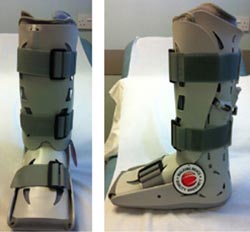What will the surgery involve?
i. Anaesthetic – usually a general anaesthetic is required; local anaesthetic may also be injected around the nerves that supply sensation to the foot and ankle (usually applied near the knee- popliteal nerve block), alternatively it is injected around the incisions at the end of the operation. The local anaesthetic should reduce the discomfort after the surgery and if a popliteal nerve block is used, the foot and ankle are likely to remain ’numb’s for 12-24 hours.
You will have a chance to discuss your anaesthetic with the anaesthetist before the operation.
ii. Incisions – a longitudinal slightly curved incision is made over the back of the Achilles tendon
iii. The surgery – The Achilles tendon ends are identified and joined together with strong sutures placed in a particular configuration, to ensure that they have adequate hold on the tendon ends.
iv. Stitches – Removable, non-dissolving sutures will be used to close the skin. These will be removed at your appointment about two weeks after surgery.
v. Dressings – Special dressings and padding together with a below knee plaster ’back slab’ are applied with your foot pointed to the floor. These should be kept in place until you are seen in the clinic two weeks after the surgery.
The plaster should be kept dry, applying a waterproof cover when showering is useful, the most commonly used can be found at www.limboproducts.co.uk
What happens after the surgery?
i. Going home – This will either be the same day or the following morning depending on the time of surgery, how easy you find using crutches and home situation (i.e. how many stairs you have etc.)
ii. Pain relief – The local anaesthetic ankle should provide some pain relief, but you will be supplied with pain relieving tablets by the hospital (usually co-codamol or paracetamol and tramadol) these should be taken regularly initially. You can gradually reduce these after a few days as your pain allows.
You will find it more comfortable to keep your foot up on a chair, if possible above the level of your heart, as much as you can for the first two weeks after surgery. This will help reduce the swelling and therefore also help wound healing.
 iii. Walking – For the first two weeks you should not apply any weight through the foot/ ankle.
iii. Walking – For the first two weeks you should not apply any weight through the foot/ ankle.
For the following 6-8 weeks your will be in a walking boot (see photos, right) with wedges under your heel, the number of wedges will be gradually reduced under the guidance of the physiotherapist.
You will be able to place all of your weight on your foot in this boot.
iv. Follow up – You will be seen in the out patients two weeks after your surgery when your plaster will be removed and the sutures removed. The plaster will be exchanged for a walking boot as described above.
You will then be referred to the physiotherapists who will guide you through a standard rehabilitation regime.
Further follow up will be determined by your progress.
v. Driving – You will not be able to drive until you can walk without crutches confidently. If the surgery is on your left foot and you have an automatic car you may be able to drive two weeks after surgery, but you should check with your insurance company first.
What are the risks of the operation?
There are a small number of risks of surgery including infection, nerve damage, blood clots, ongoing pain and the need for further surgery (please see General Risks of Foot and Ankle Surgery for further information)
